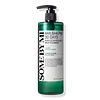What's inside
What's inside
 Key Ingredients
Key Ingredients

 Benefits
Benefits

 Concerns
Concerns

 Ingredients Side-by-side
Ingredients Side-by-side

Water
Skin ConditioningLauric Acid
CleansingGlycerin
HumectantPotassium Hydroxide
BufferingMyristic Acid
CleansingSodium Chloride
MaskingSodium C14-16 Olefin Sulfonate
CleansingLauryl Hydroxysultaine
CleansingBenzyl Glycol
SolventCoco-Betaine
CleansingSalicylic Acid
MaskingEucalyptus Globulus Leaf Oil
PerfumingButylene Glycol
HumectantEthylhexylglycerin
Skin ConditioningMelia Azadirachta Leaf Extract
Skin ConditioningDisodium EDTA
Coptis Japonica Root Extract
Skin Conditioning1,2-Hexanediol
Skin ConditioningMelia Azadirachta Flower Extract
Skin ConditioningMelaleuca Alternifolia Leaf Water
AntimicrobialEthyl Hexanediol
SolventCentella Asiatica Extract
CleansingAsiaticoside
AntioxidantMadecassic Acid
Skin ConditioningGluconolactone
Skin ConditioningCitric Acid
BufferingAsiatic Acid
Skin ConditioningMandelic Acid
AntimicrobialMadecassoside
AntioxidantArtemisia Vulgaris Extract
Skin ConditioningWater, Lauric Acid, Glycerin, Potassium Hydroxide, Myristic Acid, Sodium Chloride, Sodium C14-16 Olefin Sulfonate, Lauryl Hydroxysultaine, Benzyl Glycol, Coco-Betaine, Salicylic Acid, Eucalyptus Globulus Leaf Oil, Butylene Glycol, Ethylhexylglycerin, Melia Azadirachta Leaf Extract, Disodium EDTA, Coptis Japonica Root Extract, 1,2-Hexanediol, Melia Azadirachta Flower Extract, Melaleuca Alternifolia Leaf Water, Ethyl Hexanediol, Centella Asiatica Extract, Asiaticoside, Madecassic Acid, Gluconolactone, Citric Acid, Asiatic Acid, Mandelic Acid, Madecassoside, Artemisia Vulgaris Extract
Water
Skin ConditioningPalmitic Acid
EmollientStearic Acid
CleansingGlycerin
HumectantMyristic Acid
CleansingLauric Acid
CleansingPotassium Hydroxide
BufferingCocamidopropyl Betaine
CleansingSorbitan Olivate
EmulsifyingCocamide Mipa
EmulsifyingRosa Damascena Flower Water
MaskingLavandula Angustifolia Flower Extract
CleansingSalvia Sclarea Extract
AntiseborrhoeicHyacinthus Orientalis Extract
Skin ConditioningChamomilla Recutita Flower/Leaf Extract
AntimicrobialBorago Officinalis Extract
EmollientCentaurea Cyanus Flower Extract
AstringentHydroxyacetophenone
AntioxidantPEG-14m
Emulsion StabilisingDisodium EDTA
Methylparaben
PreservativePropylparaben
PreservativeParfum
MaskingWater, Palmitic Acid, Stearic Acid, Glycerin, Myristic Acid, Lauric Acid, Potassium Hydroxide, Cocamidopropyl Betaine, Sorbitan Olivate, Cocamide Mipa, Rosa Damascena Flower Water, Lavandula Angustifolia Flower Extract, Salvia Sclarea Extract, Hyacinthus Orientalis Extract, Chamomilla Recutita Flower/Leaf Extract, Borago Officinalis Extract, Centaurea Cyanus Flower Extract, Hydroxyacetophenone, PEG-14m, Disodium EDTA, Methylparaben, Propylparaben, Parfum
 Reviews
Reviews

Ingredients Explained
These ingredients are found in both products.
Ingredients higher up in an ingredient list are typically present in a larger amount.
Disodium EDTA plays a role in making products more stable by aiding other preservatives.
It is a chelating agent, meaning it neutralizes metal ions that may be found in a product.
Disodium EDTA is a salt of edetic acid and is found to be safe in cosmetic ingredients.
Learn more about Disodium EDTAGlycerin is already naturally found in your skin. It helps moisturize and protect your skin.
A study from 2016 found glycerin to be more effective as a humectant than AHAs and hyaluronic acid.
As a humectant, it helps the skin stay hydrated by pulling moisture to your skin. The low molecular weight of glycerin allows it to pull moisture into the deeper layers of your skin.
Hydrated skin improves your skin barrier; Your skin barrier helps protect against irritants and bacteria.
Glycerin has also been found to have antimicrobial and antiviral properties. Due to these properties, glycerin is often used in wound and burn treatments.
In cosmetics, glycerin is usually derived from plants such as soybean or palm. However, it can also be sourced from animals, such as tallow or animal fat.
This ingredient is organic, colorless, odorless, and non-toxic.
Glycerin is the name for this ingredient in American English. British English uses Glycerol/Glycerine.
Learn more about GlycerinLauric Acid is a fatty acid or lipid. About half of fatty acids in coconut oil is lauric acid.
This ingredient helps hydrate and sooth skin. As a humectant, it helps trap moisture. It also aids in cleaning and enhancing the texture of products.
Lauric acid may not be Malassezia folliculitis, or fungal acne, safe.
Learn more about Lauric AcidMyristic Acid is a saturated fatty acid. It is naturally found in milk fat. Other sources include palm oil, coconut oil, and butter fat.
Myristic Acid is an emulsifer and cleanser. As an emulsifer, it stabilizes a product by preventing ingredients from separating. Myristic Acid helps clean your skin by acting as a surfactant. It tends to gather oil and dirt on your skin to be easily rinsed away.
One study from 2021 found Myristic Acid to have anti-inflammatory properties.
Learn more about Myristic AcidPotassium hydroxide is commonly known as caustic potash. It is used to fix the pH of a product or as a cleaning agent in soap. In cleansers, it is used for the saponification of oils.
Sapnification is the process of creating fatty acid metal salts from triglycerides and a strong base. During this process, Potassium Hydroxide is used up and is not present in the final product.
Using high concentrations of Potassium Hydroxide have shown to irritate the skin.
Learn more about Potassium HydroxideWater. It's the most common cosmetic ingredient of all. You'll usually see it at the top of ingredient lists, meaning that it makes up the largest part of the product.
So why is it so popular? Water most often acts as a solvent - this means that it helps dissolve other ingredients into the formulation.
You'll also recognize water as that liquid we all need to stay alive. If you see this, drink a glass of water. Stay hydrated!
Learn more about Water